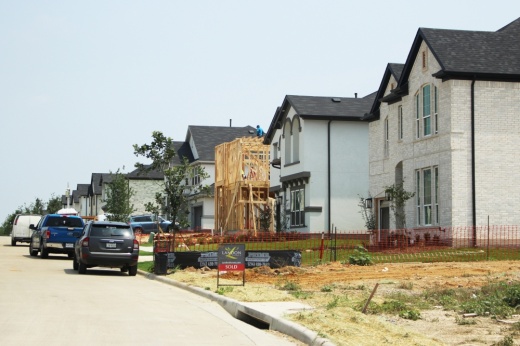The development taking place at the northeast corner of Eldorado and Coit is estimated to be valued at more than $2 billion. It is a more than 630-acre development that will bring a grocery store, 30,000 square feet of retail space and more to the area.
The grocery and retail portion of the development, called Lexington Village, will be surrounded by 2,500 single-family homes and 2,200 multifamily units.
Frisco as a whole could be less than two decades away from reaching build-out, City Manager Wes Pierson said. The city has reached about 81% build-out, which means there is about 19% of its land still to be developed.
“[Brinkmann Ranch is] just another area of land that is available to actually close the gap from that 81% to 100%,” Pierson said.
Development plans also include approximately 16 acres for city parks and 31 acres for an unknown number of Frisco ISD schools. John Landon, founder and CEO of Landon Development Company and Landon Homes, announced the plans in 2020.
“It’s all about creating a great place to live [that is] very convenient to where you’d work and play,” Landon said in 2020. “We’re excited about the location and the quality of the project that we’re going to be able to build here.”
How it started
Brinkmann Ranch was originally Box Ranch until Baxter Brinkmann bought the longhorn-scattered land following owner Cloyce Box’s death in 1993. Its most well-known claim to fame is when it was the setting for the first few episodes of the 1978 CBS television show “Dallas” until production moved to Parker.
The original zoning for the approximately 637 acres being developed on the Brinkmann Ranch land was first approved around 40 years ago, Development Services Director John Lettelleir said.
“This [land] had old zoning on it—zoning that was approved back in the late ‘70s, early ‘80s,” Lettelleir said.
That zoning allowed for 17,822 apartment units. Since then, agreements between Brinkmann Ranch representatives and the city reduced the number of multifamily homes allowed on the property by about half, Lettelleir said.
“The big thing that benefits the city is it’s not going to have all these apartments [like it] was originally zoned,” Lettelleir said.
Further agreements between Landon Homes and the city in 2020 reduced the number of multifamily homes to a set maximum of 2,480. Today, plans for the development include 2,200 multifamily homes to accompany 2,500 single-family homes.
Creating community
For the supermarket chain Tom Thumb, the growth at Brinkmann Ranch is a chance to bring something new for its residents near Lexington Village, said Christy Lara, director of public relations at Tom Thumb.
“The development of the Brinkmann Ranch area in general ... opens up a lot of opportunities,” Lara said.
The Tom Thumb store broke ground on Feb. 16. At its groundbreaking, Mayor Jeff Cheney said the store would fill a need for nearby shopping and food as the area continues to develop.
“A unique part of this part of our city is the [Brinkmann] Ranch down the street that creates this huge void,” Cheney said at the groundbreaking.
Part of the grocer void is due to the newer developments being brought into the area, Centergy Retail President West Miller said. Both Miller and Matt Enzler, Trammell Crow Residential senior managing director, were present at the groundbreaking to represent the incoming features of Lexington Village.
“With what John Landon has done with Landon Homes, and Lexington and Lexington Country, and what he’s doing now on the Brinkmann Ranch within our Lexington community, there’s a huge grocery void,” Miller said.
Until Tom Thumb opens in 2024, the closest grocery stores to Brinkmann Ranch are about 2 miles away, Miller said.
“Brinkmann Ranch, Coit and Main, Coit and Eldorado, all these residents have to travel a pretty good distance to get to the first grocer,” Miller said.
Once built, developers hope the Tom Thumb will also become a local neighborhood store for the residents in the area, Lara said.
“This particular Tom Thumb, it’s really going to be a walkable site,” Lara said. “There’s an opportunity for us to partner [with] the master plan for the area, including the apartments, green space retailers ... we’re factoring that into our store build as well.”
The grocery store will prioritize the people living nearby who will be able to walk up to buy groceries by allocating some of the parking lot to a community space, Lara said.
“It will be a place where people could sit, enjoy a meal, gather together—a safe spot in the parking lot,” Lara said.
Saving a space
Development plans for the land go beyond retail and residential.
Frisco ISD owns 113 acres of land that could be split between a future high school, middle school and elementary school, but plans are tentative depending on growth, said Matt Wixon, athletics facilitator for the FISD communication department, in an email.
“Frisco ISD does not currently have a timeline for construction of schools in the area,” FISD Chief Operations Officer Scott Warstler said in a statement.
FISD has existing expansion plans in other places across the district to meet city growth with Wilkinson Middle School and Wortham Intermediate School scheduled to open in August. Those campuses will be located on nearly opposite ends of the district’s boundaries with Wilkinson Middle in west Frisco and Wortham Intermediate in west McKinney.
“Each fall, the district evaluates our current enrollment, and works with our external demographer to update future student projections and analyze the need for additional schools,” Warstler said.
If the district does decide to go through with the new schools, it has enough funding for a potential elementary school from its most recent bond, Wixon said.
“Those [other two] potential projects would need to be funded through an additional bond,” Wixon said.
Looking ahead
Developing Brinkmann Ranch also gives the city the opportunity to continue working toward its hike and bike trail master plan.
“It will connect going further to the northwest where you eventually could ride up to the [Professional Golfers’ Association Frisco campus],” Lettelleir said.
Reaching build-out is still years away, Pierson said.
“It really depends on the economic environment and the continued growth,” he said. “It could be anywhere from seven years to 20 years.”
After Frisco hits 100% buildout, the city will move into “maintenance mode” as its attention turns away from new developments and toward helping existing developments last, Pierson said.
“Right now a lot of the revenue that comes into the city is a result of brand-new property being built,” Pierson said. “Once you hit build-out, then instead of getting new properties added to the tax rolls, it’s all mainly existing properties or maybe some redeveloped type of properties.”
More conversations surrounding city build-out are expected in the coming months, Lettelleir said. City officials began updating the comprehensive plan, a process that takes 18 months to complete, in May.
One project that could help Frisco reach full build-out is on the north side of the city.
“The Fields is another major land area that has the capacity to be able to add more commercial or housing stock to our community,” Pierson said.





